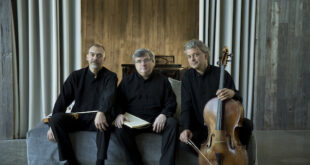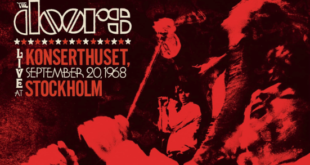Every ensemble configuration comes with its own challenges for musicians – and its own rewards for listeners. One of the trickiest formats may be the string trio. Three musicians must play as one, merging into a single soul, as it were; at the same time each expresses an essential voice alone and must be utterly sure of it.
Countless string quartets with steady memberships are touring, and in residence, all over the classical music world, with contemporary composers steadily adding to their repertoire. With far less material for the string trio, there is less demand for artists to solidify into that format. Last month the Aspect Chamber Music Series presented the Brentano Quartet, four top-tier musicians known collectively by a name, a name that gains a reputation and develops a history. Then, on May 18, the series’ season closed with music for string trio by Beethoven and Mozart, performed by three top-tier young musicians – but billed individually, as violinist Stella Chen, violist Matthew Lipman, and cellist Brannon Cho.

As Chen told me in a recent interview, the string trio format is “particularly fun (and difficult) because it is so exposed and requires virtuosic command from all three performers. The division between accompaniment and melody is less clear than in a string quartet – the roles are much more in flux and we have to dart between roles quickly and seamlessly.”
She and her fellow musicians succeeded magnificently at this in both the Beethoven String Trio in G major, Op. 9 No. 1, and the Mozart Divertimento for string trio in E flat major, K563.
Fathers and Sons
All Aspect shows are built around a theme and include a brief lecture on that theme. This time it was the influence, positive and negative, of domineering fathers on certain great composers of the classical era: Mozart, Beethoven, and – represented by Chen’s solo amuse-bouche of the famous Caprice No. 24 in A minor – Paganini. This sounded to me like a fairly thin concept for a concert. How would facts about their fathers help us appreciate the music of composers already universally beloved?
In the event, it was an enlightening evening. Aspect founder Irina Knaster herself, rather than a guest scholar, tied everything together with a compact, two-part, well researched and wisely witty talk about the fathers of artists generally – such as those of Clara Schumann, Franz Kafka, and chess grandmasters Susan and Judit Polgar – and, of course, of the composers on the program.
Chen’s stalwart Paganini had set the table; when Beethoven arrived each ingredient, each instrument, sounded distinct as the musicians leaned into the motives and harmonies with assurance, deploying both finesse and balance as they painted pictures with their bows.
A mental game I often play is to see how well my ear can pick out the viola. It’s easier with a string trio than with a string quartet, where either viola or second violin can be the “middle voice.” Either way it’s a good exercise in appreciating both harmony and counterpoint. I had some fun with it at this concert.
The second movement arrived like a garden promenade. Here, as throughout, the musicians displayed an outstanding feel for one another’s phrasing, as if they had played together for many years. The Scherzo bounced playfully, the musicians trading gestures, infusing the music with emotion and in particular, with joy. And with tremendous dexterity they made the Presto finale sound almost easy.
Beyond Diversion
While some impresario fathers have believed they could turn any child into a genius with sufficient singleminded training and practice, Leopold Mozart believed his son to be proof of the reality of divine miracles. But he was also a very practical and controlling man. Mozart had to break free from his father’s influence to become the fully rounded musical genius we know today – to “become himself,” as Knaster put it.
The Divertimento dates from relatively late in Mozart’s short life, and is far more than a diversion. It began on this occasion with a nimble, dancing spirit. Then Chen advanced the melody in the Adagio with a liquid grace; its Trio section was sublime.
The first minuet was robust, the second almost incendiary – which I realize is a strange word to apply to a formal dance. Separating the two were the intricate variations of the Andante, during which I found myself losing track of which instrument was taking the lead as the musicians steered flawlessly.
What will the Aspect Chamber Music Series bring us in its 2023-24 season? Maybe a “Mother Said” evening? Whatever the themes, the music is always stellar.
 Blogcritics The critical lens on today's culture & entertainment
Blogcritics The critical lens on today's culture & entertainment




